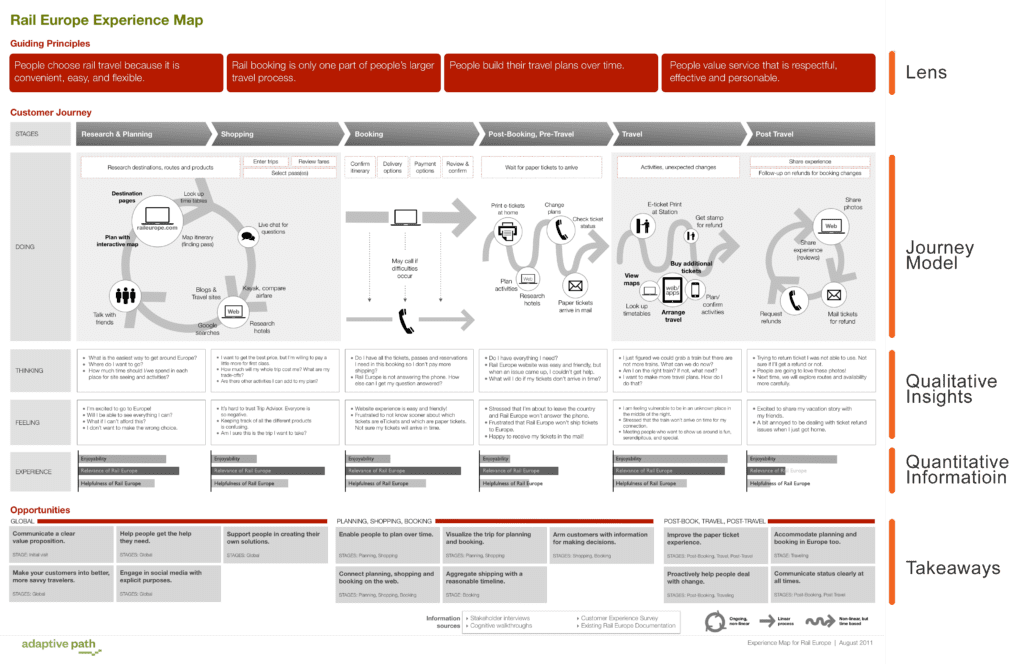
Customer Journey Mapping 101: The What, Why, and How
Customer experience improvement requires an organizational commitment that cuts across departments and teams. Orchestrate this through journey mapping.
Talk about the importance of the customer experience is everywhere these days, and it’s not just analysts or leading organizations doing the talking anymore. Delivering a consistent, low-effort customer experience from end to end has huge business benefits, but requires a fundamental organizational commitment that must cut across departments and teams.
A great way to get your organization on board to measurably improve the customer experience is to step into the customer’s shoes and experience that journey from their perspective – what your customers are doing, thinking, and feeling along the way.
Customer journey mapping will help you identify, with data, what’s working, what’s not, and will compel you to take necessary actions to improve.
I’ll walk you through what I’ve learned when my company, Code42, began mapping our customer journey and provide you with a foundation and a framework you can use at your organization.
What Is Customer Journey Mapping?
Customer journey mapping is about creating the organizational change that’s required to be truly customer-centric and make measurable progress toward your organization’s overall goals.
Here’s a more formal definition:
Customer journey mapping: A series of activities that your organization undergoes to understand and improve the overall experience that your customers or members have with your organization, from the customer’s perspective.
Note: In user experience (UX) and design contexts, this is also called experience mapping.
Customer journey mapping is an outside-in approach (different from service design, which is inside-out) designed to cut across departments, functions, and organizational silos. It allows you to identify rough spots, act, and ultimately execute better as an organization. What comes out of those activities—the artifact—is the customer journey map.
However, the research, activities, and subsequent actions are the most important part in customer journey mapping (more on that later).
Why Does Customer Journey Mapping Matter?
While most organizations say (or think) they’re customer focused, the reality is quite different. In 2005, Bain and Company released some staggering research:
80% of firms participating in the study said they deliver a superior experience, while only 8% of their customers agreed.
This difference is called the “perception gap,” and we haven’t evolved much since 2005. Similarly, a 2017 study by Capgemini found:
75% of companies believe they’re customer-centric, while only 30% of consumers agreed.
Ultimately, your customers or members are just trying to get information or complete a task when they interact with you, and research shows that organizations that make things easy do better. Forrester and McKinsey talk a lot about the importance of a consistent customer experience across all the different customer touchpoints.
Always remember: the customer doesn’t care about your org chart, and the customer certainly doesn’t care about your back-office tools.
Your organizational silos, your tools, and the intersection points between them are the most likely places where you may be creating mediocre, or even negative, experiences for your customers. When done correctly, customer journey mapping is a great way to identify, prioritize, and address those issues within the customer’s experience so you can better serve and retain your customers or members.
How to Do Customer Journey Mapping: Look to the Experts
Adaptive Path and Nielsen Norman Group have great resources available to help you undertake customer journey mapping at your organization. Adaptive Path’s resources were especially helpful to us at Code42. This is the process we used:
1. Start with a goal
2. Define scope
3. Review existing data and resources
4. Do more research
5. Do a touchpoint inventory
6. Create your map
7. Repeat
While it may be tempting to skip ahead to create your map, make sure you give the proper time and attention to defining goals, targeting scope, and doing research (reviewing, collecting, and analyzing data). This is extremely important and if you cut corners on these steps, your efforts will be significantly more difficult, your work will fail to gain traction, or likely both. Defining the scope of the customer journey map up front means you’ll know when your first pass is done. Your goals will inform everything you do are the foundation for all your activities.
When we started customer journey mapping at Code42, we had a general sense that we weren’t making things smooth enough for our customers and we wanted to find out where, so we could start addressing the biggest, ugliest issues first.
We narrowed the initial scope to our largest customers because they have the most impact on our revenue, most interactions with us, most people involved, and thus the most moments of truth (places where things could go really well or really poorly). We relied heavily on Rail Europe’s customer journey mapping process and map as a model.
The information below will help guide you when you’re ready to create your map.
The Final Step: Creating Your Map
It Doesn’t Need to Be Pretty
Creating your map can be the most intimidating part, especially for people who aren’t designers. Remember, the map itself is just one part of the project, and the least important. This is not an art project and is not about creating a pretty picture that you email to people at the end of a series of meetings. It’s about making measurable progress to improving your customers’ experience.
Make sure you don’t go too deep into the details when creating the map. The map should be a good approximation of what 80 percent of the customers within your chosen scope experience. Otherwise, it will be too overwhelming for the viewer, too difficult to update, and ultimately won’t serve its intended purpose. You can always go back and dive deeper into a specific aspect of the customer journey later. Including the right level of detail when creating your map makes it much more likely that your efforts will succeed in the long term.
But It Does Need to Work
Both Adaptive Path and Nielsen Norman Group offer great info all of this, but especially on what to include on your map. Your map must:
- Solve a business problem
- Be based on truth (research and data)
- Cite sources, to quickly establish credibility
- Stand on its own, without requiring a lengthy explanation
The Rail Europe map that Adaptive Path created is both beautiful and a great example of how to present complex information in a consumable way. Follow their guidance as best as you can, but don’t let the elegance of their work intimidate you.

Rail Europe’s customer journey map, created by Adaptive Path.
Keep the Momentum Going
Customer journey mapping is a way to help you truly build the customer into your organizational DNA. Once you have your map, bring it out and put it to use in meetings and during conversations. Put up posters. Make it accessible to your organization, whatever that means for you. The map should facilitate conversation and compel your organization to take action.
Revisit Your Map (And the Data) Regularly
The work is never really done, so make sure your map is consistently updated. Context changes, markets change, your organization changes, and your customers change. Revisit your map on a cadence that makes sense for your organization and when there’s some other major change affecting your organization and your customers.
Ultimately, the review cadence will depend on factors unique to your organization. A rapidly growing tech company like Code42 may need to review and tweak every quarter or six months, while a more mature organization may need to revisit less often.
Don’t Let the Work Fizzle Out
In summary, here’s a quick overview to guide you before, during, and after your initial customer journey mapping project.
Before:
- Tie to something that moves you forward as an organization
- Define your goals and scope
- Ensure or gain leadership buy-in
During:
- Take everyone with you
- Do research, lean on your research, and cite your sources on your map
After:
- Display the map
- Use your map for organizational planning
- Update on a regular cadence, and when context changes
Results So Far
We’ve seen a number of positive outcomes so far, and here are a few:
- During workshops, we defined single departmental ownership and supporting teams for each stage of the journey, including transitions between phases, which has helped us be more action-oriented and get more done, faster.
- We improved consistency across the entire customer journey for individual customers and across customers, which allows us to be more prescriptive, reduces overhead, and has created a better experience for our customers.
- We reduced the amount of email we send our customers and made the emails we do send more valuable.
- The journey is tied to our guiding principles with defined metrics so we are now measuring how well our customers perceive us living up to those principles, for each phase.
Additional resources
This is just a brief overview of customer journey mapping. I recommend checking out these additional resources for more information on strategy, tactics, or business benefits:
- MX 2012 | Chris Risdon & Todd Wilkens | Customer Journey Mapping (Adaptive Path, video)
- The Anatomy of an Experience Map (Adaptive Path, article)
- When and How to Create Customer Journey Maps (Nielsen Norman Group, article)
- The Decline of Consumer Trust and What to Do About It (Forrester, podcast)
- Making Journey Maps Useful: CX Measurement Edition (Forrester, article)
- Why the customer experience matters (McKinsey & Company, podcast)
- Closing the delivery gap: How to achieve true customer-led growth (Bain & Company, article)
- The Disconnected Customer: What digital customer experience leaders teach us about reconnecting with customers (Capgemini, article)
About Code42: Code42 is the leader in data loss protection, visibility and recovery solutions. Native to the cloud, the Code42 Next-Gen Data Loss Protection solution rapidly detects insider threats, helps satisfy regulatory compliance requirements and speeds incident response — all without lengthy deployments, complex policy management or blocks on user productivity. For more information, visit code42.com.
Engagement is key to knowing your customers and getting them invested in your organization. Check out key trends.




